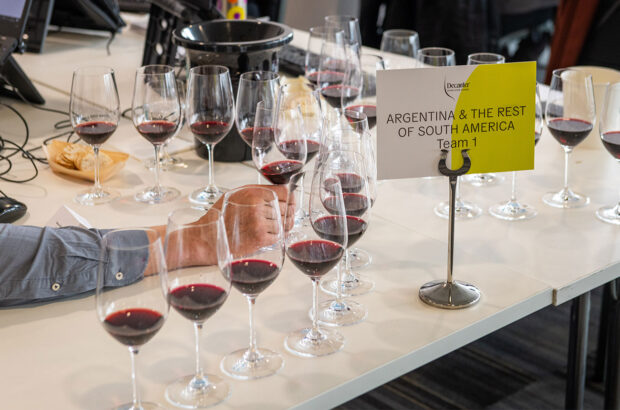Link: Find more WSET stories
- This article is written by a journalist on a journey of discovery - and on a mission to learn about wine.By Yiyao Wu from Shanghai – the Chinese perspective
Wine labels from the New World are usually easy to understand for Chinese consumers, boldly showing varieties and production regions. Information on how to understand these labels is delivered throughout the WSET Level 2 course, and I found it easier than learning about French and European labels.
- Use the where to study map on the WSET website to see which courses are available near you.
Argentina
Labels of Argentinian wines are usually written in English with obvious information related to production, vineyard site and grape varieties.
Malbec is a red variety that is worth remembering. The grape originated from France but has found its best fortune in Argentina where it is widely grown, blessed by warm climates. In the classroom my educator let us try a glass of Malbec, and I was impressed by its black fruit flavors. It tastes a little bit like Merlot, but with more body, tannin and ripeness of fruit.
Mendoza is one of Argentina’s largest and finest grape-growing regions. It’s Uco Valley produces some of Argentina’s best wines. Salta is another big region with some of Argentina’s, and even the world’s, highest altitude vineyards reaching beyond 1,500 meters. It’s Cafayate sub region produces very good Torrentes, a white grape, wines along with Malbec.
Altitude is believed to bring warmth and sunshine to vineyards during the day and cooling effects during the night, crucial to good balance in the grape’s maturing progress, thus it is usually included in labels of Argentina’s wines. These wines are hard to find in China.
Other famous regions include San Juan and La Rioja. Usually the more detailed the geographic information is given, the higher the quality of the wine is hinted.
Chile
In Chile, classification of wine is influenced by that of Spain. The label usually shows the grape varieties, and reserva is added which hints “preserved in oak barrels” and gran reserva hinting “preserved in new oak barrels for longer period of time”. But, this has no legal meaning as it does in Spain, so is sometimes used as a marketing tool.
Some labels read “Embotellado en Origen”, meaning estate bottled. Its meaning is similar to that of estate bottled in the old world that we discussed weeks before. As for “DO” (Denomination of Origin/Appellation), it is similar to AOC in France and DOCg in Italy, showing unique qualities of a legally protected geographical region.
Premier Chilean regions include Aconcagua Valley, Casablanca Valley and Maipo Valley.
For those who wish to try grape varieties Chile is famous for, Carménère is a must because it is rarely found in other countries. The red grape variety is quite “picky” and requires strict climatic conditions and crop management, yields are usually limited. After I tasted a glass of Chilean Carménère, I went to several supermarkets and famous cellars in Shanghai, and found that they are not widely accessible. I personally liked its softness and perfume-like fragrance.
South Africa
Geographical indication on wine labels from South Africa normally reads “WO”, short for Wynvan Oosprong, translated as wine of origin. These WO’s can be as large an area as Western Cape, to more detailed ones like Walker Bay or Elgin. Sub-regions like Elgin shows that the wine has unique qualities of the specific area.
In South Africa, some grape varieties are labelled under different names than are found internationally. For example, Chenin Blanc on a South African wine label is can be called “Steen”, and Riesling can be labelled as “Weisser Riesling” or “Rhine Riesling”. South Africa’s Cape Riesling, a local white grape variety, has little to do with “Weisser Riesling”.
Another local red variety is Pinotage, a crossing of Pinot Noir and Cinsualt (which is also known as Hermitage, the source of “tage” part of the grape name). I tasted a glass of Pinotage outside classroom, and was impressed by its rich and ripe taste, which goes very well with steak.
Cap Classique on a South African sparkling wine label, means that the wine was bottle-fermented, resembling the method of making Champagne in France, and is therefore of higher quality.
Australia
We are starting to find an increasingly wider range of Australian wines in China’s supermarkets, restaurants and cellars, and it is anticipated that more Australian wines will be entering into the Chinese market as the free trade agreement between the two countries takes effect. This would make Australian wines almost duty free in China in the next few years.
My educator and classmates, some of whom are working with wine merchants, said that Australian wines are really famous for their wide plantings of international varieties and vast production sites scattering all over the country. With so many options to choose from, one can just focus on grape variety, production and region.
If the region is specified, this hints at a higher quality of the wine – the famed exception is Penfolds Grange. Regional examples are: Barossa, Clare Valley and Margaret River, where as “Southeast Australia” may stand for bulk, inexpensive wines.
It really takes lots of wine tasting to understand the uniqueness of various regions and grape varieties in the New World. Reading while tasting wine may be helpful (particularly before the exam!). All this learning has made me research the possibility of joining wine tours when I go travelling as many countries have well-developed wine tourism that look quite appealing.
Updated: 30/12/15
Interested in studying for a WSET qualification like Yiyao? Learn more here.

Yiyao Wu Biography – WSET, China Based Journalist

Rest of the World – Common Wine Labelling Terms – WSET Level 2

Conditions and Growing Environment – Factors that influence wine – WSET Level 2







